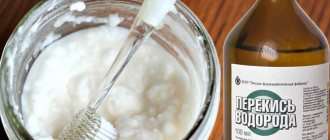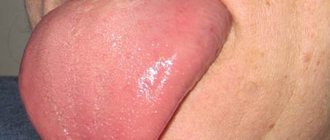It is impossible to say with complete certainty when this offal became desirable on the table and, moreover, scarce and high-status, but it is known for sure that peasants were forbidden to eat it; it was the privilege exclusively of gentlemen and people from high society.
Nowadays, this product is also an infrequent guest on the table, and traditionally dishes from it appear on the table on holidays. A lot of different dishes are prepared from beef tongue; it is used in first courses instead of regular meat; with its addition, salads are made, main courses and various gourmet snacks are prepared. Ready-made smoked, salted and marinated delicacies in various dressings are sold in store windows. But even without adding other ingredients, it is very tasty in itself and can be consumed as an independent product due to its rich, original taste. Beautifully chopped boiled tongue, neatly laid out on a plate with vegetables and herbs, will decorate any table.
Calorie content and composition of beef tongue
Beef tongue is valued not only for its high taste, it also has a unique composition. The product contains a balanced composition of protein, microelements, including sodium, potassium, iron, zinc and others, necessary for excellent well-being and full development of a person.
Depending on the methods of heat treatment, its calorie content changes:
- 100 grams of raw meat is approximately 173 kcal.
- Boiled will contain only 90 kcal.
- The calorie content of the stewed product will be 183 kcal.
Therefore, on a diet, it is better to eat it after cooking as a separate dish or by adding a light side dish of raw vegetables, and for heavy physical labor or intense training, it is recommended to stew it with the addition of healthy cereals.
Useful tips
Proper cleaning of beef tongue helps keep it soft and tender. However, in addition to the cleaning process, it is important to take into account other nuances that affect the taste of the product.
There are basic recommendations on how to get tasty and healthy ready-made beef tongue:
- It is advisable to buy meat chilled rather than frozen. Frozen food may be stale or old. If the tongue was bought fresh and frozen yourself, for subsequent cooking it is necessary to allow the meat to thaw naturally;
- Cook the chilled product for 12 hours. If the meat stays in the refrigerator longer, it will dry out and will not turn out soft and juicy;
- Boil the tongue for at least two hours;
- Cook the meat over low heat, covered, but leaving room for steam to escape;
- Peel the skin starting from the tip and moving towards the center.
Following these simple rules will help you prepare tender and tasty beef tongue, which can be served as a separate dish or used to make salads.
Selection of quality raw materials
No cooking method can correct the quality and taste of a stale, stale product, especially one with a “smell.” All the beneficial properties of the tongue are inherent only in fresh, high-quality meat. This is a product without signs of weathering, without spots and color unusual for meat - this is what the tongue should look like. By the way, the spots may be from the color of the animal’s tongue, but they cannot be confused with rottenness and signs of spoilage of the product.
An adult animal will have a very large tongue, but this may also be an indicator of old age. It will take a long time to cook.
More nutrients are found in the meat of an adult, but not an old animal. Veal, pork and lamb tongues are inferior in their benefits to beef, but are an alternative substitute due to their greater availability in stores and due to their lower cost.
The main reasons for the appearance of plaque on the tongue
- Insufficient oral hygiene, use of low-quality mouthwashes and toothpastes.
- Irregular tongue cleaning.
- The accumulation of a large number of microbes on the mucous membranes of the mouth and on the tongue, including its root, can lead to the formation of plaque, as well as bad breath.
- Drinking alcohol and drugs, as well as smoking.
- Chronic diseases of the oral cavity (periodontitis, necrotizing stomatitis, etc.).
- Systemic diseases of the body, peptic ulcer, AIDS, etc.
Useful properties of the product
Due to its rich composition, the condition of the skin improves, the immune system is strengthened, and most importantly, due to the high content of complete protein, this product is almost irreplaceable in the diet of children and pregnant women. Protein is responsible for building the muscle corset and is the main building material for a growing body. Lack of protein leads to muscular dystrophy and developmental disorders of the child's body. With a lack of protein in the diet, the skin, hair, and hormonal structure suffer.
Beef tongue is useful for anemia and during recovery after illness and surgery, as it contains a lot of iron.
There is an opinion that the tongue takes a long time to prepare. This is true if you cook it in the usual way. But almost every family has a multicooker and a pressure cooker, which reduces the need to control the cooking process to a minimum; the main thing is to choose the right mode . In a multicooker, the “stew” mode is suitable, but in a pressure cooker it’s even easier, just pour a little water into the bowl, put your tongue in and turn it on to the maximum setting. However, the list of beneficial properties of the tongue outweighs the cost and time spent on preparation, since the product:
- Contains a lot of minerals, including vitamins B, PP, zinc, which is rare in meat in such quantities. Iodine, potassium, phosphorus and iron are responsible for the production of hormones and amino acids.
- Promotes the body's production of insulin, which is important for diabetics.
- Responsible for tissue regeneration in postoperative patients.
- Makes the skin elastic.
- Does not contain connective tissue, making it easier to absorb for patients with gastritis and ulcers.
- Reduces blood cholesterol.
- It is an excellent product when dieting for weight loss, as it contains a lot of protein and little fat.
How to remove plaque from tongue at home
There are quite a few ways to clean your tongue from plaque at home: some remedies are recommended by dentists, others are passed down from generation to generation. All of them are effective, so you can clean your tongue in any way you like.
Devices for mechanical tongue cleaning
The tongue can be cleaned of white plaque mechanically using:
- Tongue cleaning spoon
Spoons. Pharmacies sell special spoons for cleaning the tongue; in appearance, they look like spatulas with rounded edges that prevent injury to the organ of taste. These products are made from high quality plastic. Plaque can be removed from the tongue with a regular teaspoon. Preferably silver, as silver has a bactericidal effect. Before use, the spoon should be thoroughly washed with soap and, if possible, treated with an antiseptic. Cleaning should be done with light movements from base to tip until all existing plaque can be removed.
- Scraper. This hygiene accessory is also made of plastic, but has a loop shape. To quickly clean your tongue, you should move the device from its base to its tip.
- Scraper
Toothbrush. Many manufacturers produce toothbrushes with special inserts for cleaning the tongue or removable heads. But you can also use a regular brush, rinsing it thoroughly after brushing your teeth. The cleaning mechanism is similar to that practiced when using a scraper or spoon. To achieve an additional antibacterial effect, you can carry out the procedure using toothpaste.
- Bandage or gauze. You need to wrap a bandage around your index finger, apply a little toothpaste to it and remove the plaque from the organ of taste, making movements from base to tip.
How to deal with plaque using traditional medicine
Traditional medicine offers a lot of ways to remove plaque from the tongue at home:
- Rinse your mouth after brushing your teeth with a tincture or decoction of sage, mint, calendula, oak bark, chamomile or St. John's wort. You can buy a pharmacy tincture and prepare a rinse solution from it: 1–2 tsp. per glass of water. To make an infusion yourself, you need to brew 1 tbsp. l. herbs in a glass of boiling water and leave the decoction for an hour. Herbal mouth rinses will help get rid of white plaque on the tongue and have a healing effect on the gums and throat.
- Rinse your mouth with vegetable oil, preferably olive or flaxseed, for a quarter of an hour. It quickly cleanses the oral cavity of plaque, heals microcracks, and destroys bacteria and fungi. The procedure must be carried out in the morning on an empty stomach, just one tablespoon of oil is enough. It is necessary to put it in your mouth and move it, making chewing movements so that it envelops the entire mucous membrane of the oral cavity. After the procedure, you need to spit out the oil and rinse your mouth well.
- Drink a decoction of flax seeds in the morning on an empty stomach. It’s easy to prepare: you need to brew 1 tbsp in a glass of boiling water. l. seeds and let them brew for an hour.
- Rinse your mouth with an aqueous solution of propolis or chew its pieces. Basically, solid propolis is used when it is not possible to brush your teeth or tongue by other means. It has excellent antibacterial properties.
- Finish each meal with fruit. The acids they contain will cleanse the tongue of bacteria and food particles stuck between the villi and papillae.
You can clear your tongue of plaque by rinsing your mouth with a soda solution. To prepare it, you need to mix 2-3 tsp. soda with a glass of boiled water. White coating can be quickly removed from the tongue by brushing it with a brush sprinkled with a pinch of soda.
How to properly clean your tongue from plaque
In order to properly and effectively clean your tongue from plaque at home, you should follow a few simple but very important rules. Cleaning your tongue from plaque should be done as follows:
- Be sure to brush your teeth and rinse your mouth before the procedure.
- When cleaning, rinse the scraper or spoon with water and wash your tongue.
- Each time after cleaning the organ of taste, it is necessary to rinse your mouth with any pharmaceutical rinse or herbal tincture, and also disinfect the scraper or spoon.
- You need to clean your tongue from white plaque without using toothpaste, but if its use is necessary, you should choose products that contain a minimum of menthol.
- Smokers find it easier to remove plaque with tooth powder or toothpaste.
- The tongue should be cleaned with gentle movements from base to tip, avoiding excessive pressure.
If you experience a gag reflex, do not try to clear your entire tongue the first time. It is enough to start by cleaning its tip, getting used to the unpleasant procedure every day.
How to properly cook and clean beef tongue
There are several ways to cook a tongue.
First way
If the tongue is cooked for slicing, then pre-boiled water is poured into the pan, the tongue is put in, everything is brought to a boil and cooked over reduced heat for 10-15 minutes. Then the water in which the tongue was boiled is drained, clean boiling water is poured in, and cooked until ready. This is done so that, along with foam, unpleasant odors and dirt located on the rough surface of the hard skin of the product are removed from the tongue. During cooking, and the cooking time, depending on the weight and age of the animal, can reach up to 3 hours, you should monitor the water level so that it does not boil away, and add boiling water if necessary.
How to choose
If the product is not fresh or has been frozen and defrosted several times, then you are unlikely to be able to prepare a tasty and appetizing dish, so it is better to take the advice of experienced chefs so as not to make a mistake in your choice:
- the color of the tongue should be bright pink or purple, a pale pink shade is obtained after defrosting, and gray when the product begins to deteriorate;
- the smell should not cause unpleasant sensations. If a foreign aroma is felt, it means that the product was soaked with potassium permanganate or other additives;
- A clear liquid and drops of bright red blood should appear on a cut of a fresh product.
There is an easier way to determine the freshness of beef tongue - press the tongue with your finger. If the shape is restored within 10-15 seconds, then it is a fresh product. Otherwise, one should doubt its quality.
The benefits of the finished dish will depend on the amount of time spent on its preparation. The longer the tongue is cooked, the less nutrients remain.
The age of the animal can be determined by the weight and color of the offal: the tongue of a young calf weighs up to 1 kg, and an adult animal weighs 2-2.5 kg. A bright pink color indicates that the animal was still young, and a dark red color with a purple tint indicates that the animal is quite old.
The supermarket usually sells frozen food. To prevent it from losing its beneficial properties, defrosting is done gradually, avoiding temperature changes. The bottom shelf of the refrigerator or a bowl of cold water is suitable for these purposes.
Now you can start cleaning the offal.
How to properly clean your tongue
Step-by-step instructions for cleaning the product are as follows:
- Raw reeds need to be cleaned of dirt and mucus. It is advisable to pre-soak the offal in cold water; you can leave it overnight.
- Anything that gets wet should be cleaned off with a knife, scraping off the plaque and removing any remaining meat and salivary glands at the root.
- Rinse before storing in clean running water.
- Place in a saucepan, add boiling water and bring to a boil.
- Remove the foam, boil for 15 minutes and remove if the semi-finished product will be peeled at this stage. If it will be cleaned at the end of cooking, then reduce the heat, remembering to remove the foam with a slotted spoon, and simmer at a barely noticeable boil until done.
- If the skin is cleaned after preliminary boiling, then you should transfer the meat to cold water and wait until the moment when you can pick it up with your hand.
- Peel off the skin. It will have a white tint and easily move away from the main mass when prying it with a knife.
- If necessary, finish cooking by pouring clean boiling water and adding spices to taste.
What to peel raw and what to peel cooked?
In order for the beef tongue to be tender and have a pleasant taste, you need to clean it properly. The procedure is carried out in two stages.
- A raw tongue must be cleaned of dirt, mucus or remaining blood. Before this, the offal is soaked for at least half an hour, or better yet for an hour, in cold water. Anything that needs to be cleaned will become wet, making it much easier to remove waste from the surface of the tongue. After removing the meat from the water, pat it dry with a paper towel. Clean thoroughly, but with light movements, scraping off any unpleasant residue, while at the same time cutting off any remaining meat from the neck and fat, if any. Wash before cooking in running cold water. The skin remains uncovered for now.
- The second stage of cleaning takes place after the beef tongue has already been cooked. It is immersed in cold water, boiled after boiling for 15 minutes, the boiling water is drained, the pan and meat are washed. The next time it goes straight into fresh boiling water, where it cooks for 2.5-3.5 hours, depending on the size of the piece and how young the animal was. Together with it you can boil bay leaves, onions and carrots. You can add salt to the broth only at the last phase, when readiness is almost reached. Otherwise, the delicate product will turn into hard fibers.
We recommend: Quick and easy installation of eyelets for curtains with your own hands: just know the design
After the beef tongue is ready, place it directly from boiling water into cold water for a minute.
Advice
In order to check readiness, you need to pierce the offal with a knife. A clear liquid will be released from the finished tongue. If the meat is still damp, the liquid will be cloudy.
Further cleaning will be very easy: the skin begins to easily separate from the surface of the meat, you can pick it up in one place with a knife and pull it off almost entirely from the entire surface.
Advice
You can clean your tongue after cooking only until it cools down. If you leave the film, all you have to do later is cut it off with a knife.
We recommend: How to clean tripe!
Black coating on the tongue
The appearance of a dense and thick black coating on the tongue may be associated with the presence of serious diseases in a person:
- Ulcerative colitis (chronic inflammatory disease of the colon mucosa).
- Dehydration (dehydration of the body).
- Cholera (acute intestinal anthroponotic infection caused by bacteria).
- Diseases of the gallbladder (biliary dyskinesia, cholelithiasis, chronic cholecystitis, etc.).
- Pathological changes in the pancreas.
- "Black hairy tongue." This disease manifests itself as the growth and keratinization of filiform papillae in the middle and posterior third of the tongue and a change in their color to brown or black. It most often develops in middle-aged and elderly men and is a sign of poor oral hygiene or addiction to smoking and alcohol. Predisposing factors may include gastrointestinal diseases, vitamin deficiency and infectious diseases.
Tongue scraper
One of the most necessary accessories for oral care is scrapers for regular tongue cleansing.
A special scraper perfectly cleans the tongue, removes all plaque without scratching the surface of the tongue. Recommended for use with mouth rinse.
Benefits of a tongue scraper:
- Helps freshen breath;
- Improves the sensitivity of taste buds;
- Eliminates bacteria;
- Makes it difficult for infection to enter the body;
- Prevents disease of teeth and gums.
Gray, brown or green coating on the tongue
- A gray coating on the tongue often appears with ulcerative lesions of the intestines.
- A brown coating on the tongue appears from frequent smoking.
- A green coating on the tongue appears quite rarely with candidal glossitis, the causes of which may be decreased immunity or indiscriminate use of antibiotics.
Cleaning your tongue with a tongue scraper
Cleaning the surface of the tongue should be an essential part of daily oral hygiene, as the tongue is an ideal place for bacteria to grow. For this purpose, many companies specializing in the manufacture of products for the oral cavity offer special devices that are a combination of a brush and a tongue scraper. The brush has a round, elongated shape with soft bristles.
The brush field itself also has a round shape. The length of the brush ensures that all areas are easily and thoroughly cleaned. The flat shape greatly facilitates manipulation in the oral cavity and prevents the gag reflex. Used to remove plaque from the tongue, thereby preventing the occurrence of caries and bad breath. Provides healthy gums, a feeling of freshness and comfort, improves taste.
How to prepare offal for cooking?
The meat will turn out tender, juicy and aromatic only if it is properly pre-processed. Regardless of whether you plan to boil pork tongue or beef tongue, you need to take into account the following points:
- If you clean the component before cooking, there is a risk of ruining it beyond repair. Firstly, cleaning will take a lot of time, because... the skin will come off reluctantly. Secondly, a significant amount of the edible part will definitely be removed along with it. Finally, such a protective film retains moisture, making the dish juicy.
- But all excess meat and fat should be cut off. Their presence increases the calorie content of the broth, especially if it is pork tongue. Because of this, the dish turns out to be too rich and even greasy.
- Even if the offal is purchased in a good store and has obviously been pre-treated, it should be washed and scrubbed with a brush.
- It is worth considering that the tongue cooks for several hours, so you will have to add water during the process. To do this, you should stock up on boiled water; you should not use tap liquid or drinking water.
When planning to boil pork tongue, you should consider using a slow cooker. It makes the offal especially tasty. But for beef preparation, the traditional option is better - in a pan.
Plaque on the tongue with spots
If an uneven coating in the form of spots appears on the tongue, then most likely this may be associated with certain diseases:
- Fungal stomatitis (oral candidiasis). With candidiasis, a white, cheesy coating appears both on the tongue and in other parts of the oral cavity. In this case, plaque in the form of spots covers the back of the tongue and its lower part, and the spots can change their location. After removing such plaque, small ulcers remain under it that bleed. Most often, candidiasis occurs in infants, as well as in people with reduced immunity. Candidiasis can also be caused by uncontrolled use of antibiotics.
- Glossitis (inflammation of the tissues of the tongue). The pathological process covers large areas of the tongue and creates a pattern similar to a map. That is why another name for desquamative glossitis is “geographic tongue.” With glossitis, red or burgundy spots with clear boundaries appear on certain parts of the back of the tongue. In this case, the patient feels itching, burning and dryness. The causes of glossitis can be symptomatic manifestations of pathological processes occurring in the body, especially the gastrointestinal tract, diseases of the hematopoietic organs and endocrine system, as well as an imbalance of vitamins or puberty in girls.
How to clean your tongue?
You can clean your tongue using the following hygiene products:
- tongue scraper - looks like a brush with a long handle and a flat head equipped with bristles. Due to its width, it does not put pressure on the tongue and does not cause a gag reflex. Tongue scrapers are suitable not only for the tongue, but also for removing plaque from the cheeks.
- tongue cleaning spoon - an elastic attachment for an irrigator with a spoon-shaped tip. After brushing your teeth, you need to run this spoon over your tongue to remove plaque. Some people prefer to use a wooden or silver spoon for this purpose. However, it should be used individually and only to clean the tongue.
- multifunctional toothbrush - a toothbrush equipped on the back with a rough surface for cleaning the tongue. Multifunctional toothbrushes are less convenient than spoons and tongue scrapers, but they save time by simply turning the brush over to the other side after brushing.
It is not very convenient to clean your tongue with an ordinary toothbrush - it is too bulky, and the bristles may seem too stiff. Also, strong pressure with a brush on the root of the tongue can cause a gag reflex. Therefore, it is better to use special devices to clean your tongue.
How to remove the skin from beef tongue
Advice to housewives who read our site on how to quickly and easily remove the skin from the tongue. We will talk specifically about boiled beef tongue, since, unlike pork, it has especially thick and tough skin, which causes difficulties in removing it.
To easily remove the skin from the tongue, you need to cook the tongue for a long time and patiently until it is completely cooked. The cooking time for beef tongue depends on its size and the age of the animal. On average, the process takes 2-3 hours in a regular saucepan or 40-50 minutes in a pressure cooker (for details, see the recipe “how to boil beef tongue”).
Some housewives remove the skin from the tongue almost at the beginning of cooking, 15 minutes after the water boils in the pan, but this is inconvenient, and the process is not so simple (I can’t even imagine how to remove the skin from a raw tongue).
We recommend that immediately after the tongue has cooked and you have turned off the stove, carefully remove it from the hot broth and place it under a generous stream of cold water. The surface of the tongue will quickly cool down and the skin will come off effortlessly.
Cleaning raw tongue before cooking
As already written above, it is simpler and easier to remove the skin from an already boiled product. But if you plan to fry or stew a delicacy, then long-term preliminary heat treatment is unacceptable. In this case, cleaning is performed according to the following scheme:
- prepare the tongue for cooking (as described above);
- lower it into boiling water for 2-3 minutes;
- place in a bowl or other container with very cold water for 1-1.5 minutes;
- prying the surface layer with a fork or knife, remove all the skin.
In some cases, it is necessary to lower the tongue into boiling water again.
Meat cleaned in this way is considered completely raw. Then it can be salted, pickled, fried or baked.
There is another way to clean raw pork tongue. Its technology is based on the use of cold. The purchased offal must be washed, but not soaked. Next, wrap it in a clean bag and place it in the freezer for a short time - only the top layer should be frozen.
Using a thin and sharp knife, pry off the skin (the flesh should remain intact);
To prevent the product from slipping out of your hands, you can hold it by the edge with a waffle towel.
The surface layer must be separated in a spiral, otherwise it will tear into pieces, which will make the cleaning process longer and more labor-intensive.
Cleaned pork offal can be stored in the refrigerator for at least 2 days, therefore, when preparing for the celebration, it is allowed to prepare it in advance.
How to clean a delicacy product before smoking and salting?
If you plan to smoke or salt the beef tongue, then it should be cleaned in a completely different way.
- First, thoroughly clean the component, as before cooking. True, in this case, you can do without prolonged soaking.
- Now the product should be frozen, not to completely harden the fibers, but to freeze the top protective layer. The component can be cleaned without this, but the process will be lengthy and troublesome.
- We take a very sharp knife and cut the surface layer on the slightly hardened component. We pry up the skin and begin to unwind it, tearing it away from the base. You need to work in a spiral, not along or across. If you peel the skin like you peel an orange, it won't tear and you won't have to start all over again.
The workpiece can be sent for smoking and salting. The final dish will turn out tender and juicy if you choose the right recipe and follow its recommendations strictly. But it is not recommended to stew such a product; practically no useful components will be preserved in it, and the texture will not please you. For such an effect, it is better to use a product boiled in a traditional way.
Yellow coating on the tongue
The appearance of a bright and dense yellow-gray coating on the tongue may indicate the presence of the following diseases:
- Diseases of the liver and bile ducts.
- Early stages of hepatitis A.
- A dense yellow-green coating on the tongue may be associated with diseases of the gastrointestinal tract and bile duct dyskinesia.
List of required tools
Pork tongue, like beef tongue, can be cleaned raw or boiled. The second option is preferable, but in any case, the procedure will require a knife, a container of water and a metal scraper.
To clean your tongue with minimal loss of valuable meat, you must first boil it. Otherwise, a lot of pulp will be cut off along with the skin. And it will take much more time to clean.
If you purchased frozen tongue, you must first defrost it at room temperature. It is not recommended to speed up the thawing process using heat. Such manipulations negatively affect the structure of the pulp - it becomes dark and hard.
And it is best to buy a fresh product that has not been frozen. The age of the pig also plays a role; the younger it is, the more tender the meat will be.









